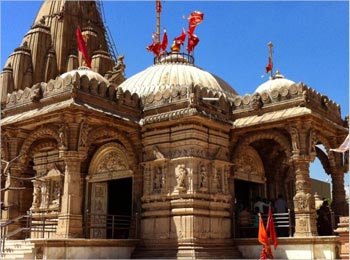Shankaracharya Temple

Information of Shankaracharya Temple, Srinagar, Jammu and Kashmir
The Shankaracharya temple which is also well identified as the Jyesteshwar temple can be seen installed on the top of the hill of Srinagar which is near about 1100 feet high from the ground level. The hill is popularly known as Takht-e-Suleiman and is one of the most beautiful sites for the visitors. It can be mentioned that the temple is basically dedicated to God Shiva and is considered to be the oldest temples in Srinagar. It was constructed by Raja Gopadatya in the year 371 B.C. after whom the temple has been named. It is said that the name of the temple was changed later on from Gopadari to Shankaracharya.
Shankaracharya Temple Religious Importance
The temple has not only gained prominence in India but also the entire world. The reason behind this fact is that the temple tends to represents the basic of rituals of Hinduism. In terms of hymning of slokas and devoting prayers to the God, the temple has been symbolizing the convectional beliefs as well as customs of the Hindus. From the time when the Hindu religion was formed in India, many customs have tried to follow it. Shankaracharya temple tends to offer a complete overview of the Hindu faith for those who want to follow Hinduism.
Shankaracharya Temple Mythology & History
According to the experts, it is said that the temple was constructed by Jalauka in the year 200 B.C. However, the temple was rebuilt by Gopadatta, the King of Kashmir and dedicated the temple to Jyesteswara. The hill on which the temple was built was known as Gopadri and the village is known as Gopkar. During the rule of Gopadatta, many temples were constructed. It was during this period the ground of the temple in the hill cracked. It was found that the Hindus raised objection when Gopadatta asked one of his minister named as Sulaiman to repair the temple as Sulaiman followed another religion. During this period, Hazrat Yuzu Asaph who considered himself to be the messenger of God ordered people to follow his words. Under the order of Hazrat Yuzu Asaph, Sulaiman completed the repair of the cracked ground in the temple.
According to some legends, it is said that the temple was actually a Buddhist temple which was altered to Hindu site of worship by Adi Shankaracharya. Many Persian writings were also found within the temple. According to numerous experts, the present temple was constructed later. However, the foundation of the structure is not too old. As per Srivara Budsah who ruled from 1420-1470 A.D. was responsible to conduct repair work within the temple. It is to be mentioned that the name of the temple as Shankaracharya came into existence when Governor Sheikh Mohi-Ud-Din did construction work in the temple. The temple was consecrated as Shankaracharya temple and installation of the Shiv Lingum also took place at that time.
Shankaracharya Temple Architectural Importance
It can be mentioned that the temple has been constructed upon the solid rock. The square building has been supported by a 20 foot octagonal base. One can reach the terrace of the temple with the help of the staircase which is made of stone. There is a doorway made on the opposite side of the staircase that leads you towards the interior of the temple. The temple has been developed in the early Kashmiri style. It tries to specify the horse shoe arch that is evident in the final stages of the temples architecture.
- Andhra Pradesh Temples
- Assam Temples
- Bihar Temples
- New Delhi Temples
- Goa Temples
- Gujarat Temples
- Jammu and Kashmir Temples
- Karnataka Temples
- Kerala Temples
- Madhya Pradesh Temples
- Maharashtra Temples
- Odisha Temples
- Punjab Temples
- Rajasthan Temples
- Sikkim Temples
- Tamil Nadu Temples
- Telangana Temples
- Uttar Pradesh Temples
- Uttarakhand Temples
- West Bengal Temples